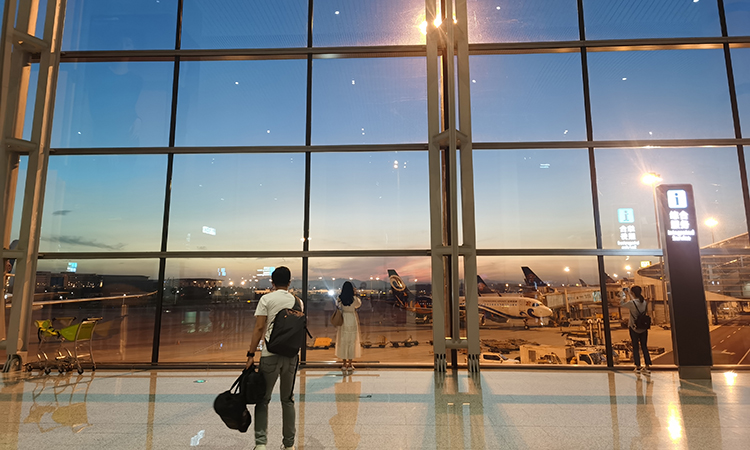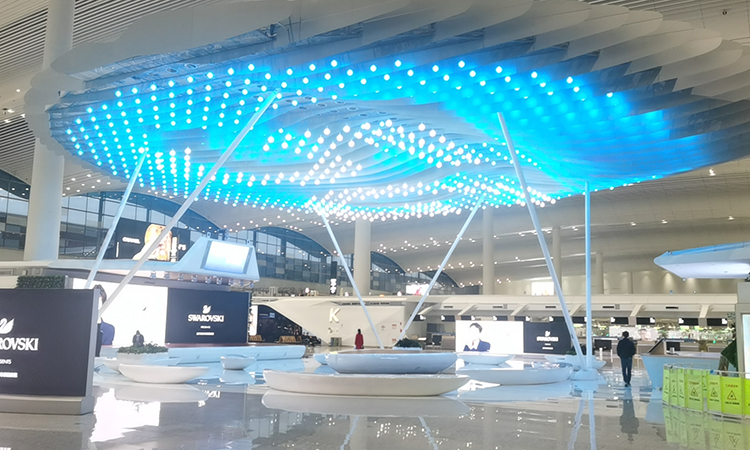Building trust in a seamless passenger experience
Posted: 3 February 2021 | Carol Lobato | No comments yet
Carol Lobato, Deputy General Manager at Guangzhou Baiyun International Airport Terminal 2, details the hard work that goes into creating an effortless, stress-free experience for passengers, and the importance of trust, now more than ever, in building and keeping relationships that will see those passengers return.


Credit: Guangzhou Baiyun International Airport
The aviation industry works endlessly to improve the passenger experience. According to Airports Council International (ACI), passenger experience is: “A hassle-free travel experience with excellent price and service competition.”
The majority of passengers are ‘educated’ by the industry on what their ‘experience’ should be, and not necessarily the other way around”
In this pursuit, the majority of passengers are ‘educated’ by the industry on what their ‘experience’ should be, and not necessarily the other way around. This is because common standards are defined and implemented based on individual processes and services. In addition, the international standards may have stereotyped passenger expectations, hence, airport operations do not deviate too drastically from one airport to another.
These pre-conceived standards contribute to passengers’ expectation of certain facilities and services at their gateways. The service quality level approach is often based on the individual touchpoints. They are handled as different units. Therefore, the whole airport experience is not considered as an entity, which may result in a distorted overall passenger satisfaction perception.
The question is, are airport operators truly addressing the underlying needs of passengers when they travel?”
The question is, are airport operators truly addressing the underlying needs of passengers when they travel? Many of us are privileged to have travelled, some more frequently than others. Even for the most seasoned traveller, one of the more common psychological aspects is a certain degree of anxiety, mostly coming from events that they have no control over, yet are disruptive to their plans and schedules. For example, delays and cancellations. In today’s pandemic environment, hygiene and health-related risks are being added to the list. So, what is the real need of today’s passengers?
Pinpointing what passengers truly need
We believe that trust and confidence are the real underlying needs that we must address, as they are at the core of the passenger experience”
At Guangzhou Baiyun International Airport (CAN) Terminal 2, we believe that trust and confidence are the real underlying needs that we must address, as they are at the core of the passenger experience. Trust is an element that is built over time. It takes all stakeholders to hold the same vision, mission and values to build this trust under one roof. The epitome of trust in the airport environment is to create a one-face, one image to passengers. Regardless of where they find themselves in the process, passengers can enjoy the same high standard, oneness experience. This uninterrupted theme is perhaps the seamless experience that passengers are looking for.
This explains the need for a holistic approach to plan the services on offer at any airport. Every touchpoint or service, no matter how different in nature, must become part of an entity. There should be a connection that links these different units together to make it one product to the passenger. One crucial consideration is to allow passenger needs and expectations become the drive behind an airport’s development as a package, not as individual service items.


Credit: Guangzhou Baiyun International Airport
Spring Breeze Service
The Spring Breeze Service accounts for an extensive, detailed and well thought-out holistic service concept and plan”
Guangzhou Baiyun International Airport’s service branding is called the ‘Spring Breeze Service’. Spring Breeze offers warmth and is soothing. It is gentle and balmy, placid but delightful. Spring Breeze is as natural as it is dependable. The Spring Breeze Service accounts for: An extensive, detailed and well thought-out holistic service concept and plan; a vision and mission that is accepted by all stakeholders at all levels; and top-notch precision in execution to appear natural and effortless to passengers – hence, stressless. It takes the entire airport community to participate and contribute, because each step and detail counts for passenger experience, which is a trust/confidence building journey. Only then can we begin to offer a seamless passenger experience.
Post-COVID-19 passenger experience
Today, hygiene and health-related issues are dominant in creating trust and confidence and will mandate a prolonged sustainability. We see how habits are instilled almost instantly – handwashing, sanitisation, social distancing, wearing of masks and the exponential use of personal protective equipment (PPE) when travelling.
Our challenge is to maintain the stressless travel feeling by adjusting our processes and facilities to meet the new needs”
Our challenge is to maintain the stressless travel feeling by adjusting our processes and facilities to meet the new needs. Apart from the installation of touchless facilities where appropriate and possible, airports vie to design simplified processes at checkpoints to reduce waiting times and high concentrations of people in queues. This also calls for a complete review of current norms and regulations. Are we able to eventually work on a single checkpoint, satisfying the different stakeholders’ needs, in terms of safety, security and other border regulations to reduce queuing times and frequency? This calls for an international collaboration that the International Air Transport Association (IATA) is working tirelessly on.
With reduced flights and passengers, we saw the need for extra effort from our staff to bridge the gaps between passengers and the facilities”
At this juncture, Guangzhou Baiyun International Airport has implemented a series of measures and technologies to uphold the Spring Breeze Service spirit whilst adhering to all of the hygiene and health-related norms conveyed by the Civil Aviation Administration of China (CAAC). Still, nothing can replace human service, which is the core of the Spring Breeze Service. With reduced flights and passengers, we saw the need for extra effort from our staff to bridge the gaps between passengers and the facilities. Passengers travel with uncertainty – will they arrive safely and smoothly at their destination without contracting the virus? What will the quarantine be like? How uncomfortable will it be to travel in PPE? The list goes on.


Credit: Guangzhou Baiyun International Airport
Seamless passenger experience
We easily fall prey to the tendency of focusing, following and implementing trends
What is behind the passenger experience cliché is, perhaps, ‘nothing can replace the human touch’. We easily fall prey to the tendency of focusing, following and implementing trends. The overwhelming development of artificial intelligence (AI) has changed the industry to such an extent that it is becoming somewhat apparent that human touch is slowly being phased out.
The industry is moving towards a smart airport approach at lightning speed. The aim is to reduce passenger waiting time through the introduction and continuous enhancements of AI-based self-services. It is certainly a valid move, as time spent in queues translates into reduced time enjoying the other facilities – the added-values that an airport offers.
What needs addressing is how to redeploy the human factor in services to co-exist with AI in offering a seamless passenger experience”
What needs addressing is how to redeploy the human factor in services to co-exist with AI in offering a seamless passenger experience. For example, travellers’ cultural needs when travelling in China: Linguistic and cultural barriers do add to the need for psychological support that AI cannot offer. The same goes for tailor-made services unique to passengers with reduced mobility (PRMs).
How to weave human service and technology so that they compliment each other is key to delivering the seamless passenger experience that our customers truly await at each departure and arrival, at an airport they trust.
In June 2019, Carol Lobato joined the management team of Guangzhou Baiyun International Airport Terminal 2, in the capacity of Deputy General Manager, overseeing services, operations and, recently, resources management, contributing to the second consecutive Skytrax 5-Star Terminal award, Best Airport Award by CAPSE (CAAC) and is actively involved in the pandemic management and operations at Terminal 2, which achieved a zero case record in 2020.
AI in Action: Enhancing Ground Operations at Frankfurt Airport
30 Sept 2025 | 11:00 AM BST | FREE Virtual Panel Discussion
Airports face mounting pressure as passenger volumes grow and turnaround windows tighten. But what if you could see your ground operations in real time, and predict issues before they occur?
Join us for a high-impact virtual panel featuring Frankfurt Airport, FraAlliance, and zeroG – Lufthansa Group’s AI powerhouse, as we explore how AI and computer vision are reshaping airside efficiency, safety, and collaboration.
Meet the experts:
- Pascal Schimanski, Project Lead – Digitalisation, FraPort
- Pauline Nolte, Project Director Strategy & Consulting, FraAlliance
- Christian Ritter, Head of Product & Principal Data Scientist, zeroG
- Moderated by Francesca Vetter, Head of Marketing, zeroG
Register now to ask your questions live and take away practical, proven insights on applying AI at scale in your airport – Register Now – It’s Free!
Related topics
Airport crisis management, Airside operations, COVID-19, New technologies, Passenger experience and seamless travel, Passengers with reduced mobility (PRMs), Safety, Terminal operations
Related airports
Related organisations
Airports Council International (ACI World), Civil Aviation Administration of China (CAAC), International Air Transport Association (IATA)


















